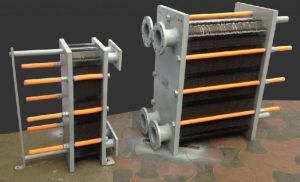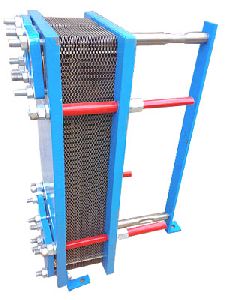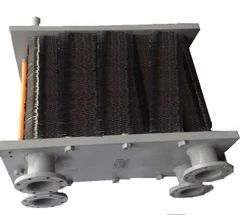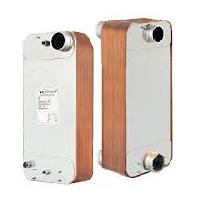
Brazed Plate Heat Exchanger
Get Price Quote
Brazed Plate Heat Exchangers consists of a series of thin, corrugated plates which are mentioned above. These plates are gasketed, welded or brazed together depending on the application of the heat exchanger.

Brazed Plate Heat Exchanger
Get Price Quote
We are the leading manufacturers of Air heat exchangers in India. Brazed Plate Heat Exchangers represent the most compact, rugged and cost-effective means of transferring heat in many industrial and refrigerant applications. Built from 316 stainless steel with copper brazing materials, they provide exceptional corrosion resistance. The SB-Series features corrugated plates that produce highly turbulent flow in a true counter-current direction. This results in high efficiency and a very compact heat exchanger design. Due to the smaller size and reduced material content, they can be the most economical heat transfer choice.API Heat Transfer Brazed Plate Heat Exchangers are available for process and refrigeration applications. Made from stainless-steel plates and copper or nickel brazing materials, they are suitable for a wide variety of heat exchanger applications. Specifications : The brazed plates form two separate channel systems. The two media assume a true countercurrent flow, completely isolated from each other. This channel configuration is designed to produce high turbulence, promoting maximum heat transfer. Applications : Hydronic heating Domestic hot water heating Radiant heating Snow & ice melting Chilled water cooling Beer & wort chilling Hydraulic oil cooling Outdoor wood furnaces/stoves/boilers and other water to water and liquid to liquid heat transfer applications. Advantages : Flexibility to change plate arrangement and to add or remove plate Optimized heat recovery Easy maintenance and suitable for CIP, plate pack easily accessible No mixing of product High heat transfer coefficients Compact constructions
Best Deals from Alfa Laval Heat Exchangers

Tube Heat Exchanger
Get Price Quote
Tube Heat Exchanger in which the tubes extend through oversized holes in a liquid distribution plate. Liquid flows through the holes & down each tube exterior surface as a falling film. A spacer or clip, desirably of wire, is placed in each hole around each tube to center the tube so that the film has a uniform thickness. The clip is self-locking & remains fixed securely in position.

Tube Heat Exchanger
15,200 Per Piece

Plate Heat Exchangers
Get Price Quote
We manufacture and supply highest quality range of plate heat exchanger using the most advanced technology for a wide series of heat transfer applications used in various industries such as chemical industry, offshore, oil and gas, petrochemicals power plants, pulp and paper, steel, zinc and aluminium, sugar, vegetable oil, breweries / distilleries, dairy / beverages and others. The difference lies at plate design, sealing technology, capacity range, product range etc. We always continue to improve our Plate heat exchanger to give total customer's satisfaction. Plate Heat Exchanger Features High heat transfer coefficients Optimized heat recovery Compact constructions No mixing of product Flexibility to change plate arrangement and to add / remove plate Easy maintenance and suitable for CIP, plate pack easily accessible. Plate Heat Exchanger A plate type heat exchanger is a type of heat exchanger that uses metal plates to transfer heat between two fluids. This has a major advantage over a conventional heat system in that the fluids are exposed to a much larger surface area because the fluids spread out over the plates. This facilitates the transfer of heat, and greatly increases the speed of the temperature change. It is not as common to see plate heat exchangers because they need well-sealed gaskets to prevent the fluids from escaping, although modern manufacturing processes have made them feasible. Plate Frame Heat Exchanger Application Plate Frame Heat Exchanger Cleaning Plate and Frame Heat Exchangers Animation Plate and Frame Heat Exchanger Approach Plate finned type Heat Exchanger Brazed Plate Heat Exchangers Plate Heat Exchanger Design The concept behind a plate heat exchanger is the use of pipes or other containment vessels to heat or cool one fluid by transferring heat between it and another fluid. In most cases, the exchanger consists of a coiled pipe containing one fluid that passes through a chamber containing another fluid. The walls of the pipe are usually made of metal, or another substance with a high thermal conductivity, to facilitate the interchange, whereas the outer casing of the larger chamber is made of a plastic or coated with thermal insulation, to discourage heat from escaping from the exchanger. The plate heat system (PHE) s was invented by Dr Richard Seligman in 1923 and revolutionized methods of indirect heating and cooling of fluids. Plate exchanger one is composed of multiple, thin, slightly-separated plates that have very large surface areas and fluid flow passages for heat transfer. This stacked-plate arrangement can be more effective, in a given space, than the shell and tube heat system. Advances in gasket and brazing technology have made the plate type heat system increasingly practical. In HVAC applications, large exchangers of this type are called plate-and-frame; when used in open loops, these heat system are normally of the gasket type to allow periodic disassembly, cleaning, and inspection. There are many types of permanently-bonded plate heat system, such as dip-brazed and vacuum-brazed plate varieties, and they are often specified for closed-loop applications such as refrigeration. Plate heat systems also differ in the types of plates that are used, and in the configurations of those plates. Some plates may be stamped with "chevron" or other patterns, where others may have machined fins and/or grooves. Liquid foods such as milk, fruit juices, beers, wines, and liquid eggs are pasteurized using plate-type. Wine and fruit juices are normally deaerated prior to pasteurization in order to remove oxygen and minimize oxidative deterioration of the products. Plate Type heat exchanger consist of a large number of thin, vertical steel plates that are clamped together in a frame. So it may called as Plate and Frame. We manufacture Plate Heat Exchanger that are used in dairy, pharma and biotechnology, beverages, brewery, chemical and power sectors. PHE plates are available in MOC AISI 304, AISI 316, AISI 316L, Titanium, Hast alloy, Monel in range thickness from 0.5mm to 0.9mm. It is suitable for handling fluid from 100 LPH to 3.5 Million LPH. The plate heat exchanger sare available in herring bone, free flow and semi welded construction and depending on application respective plates are selected. Plate heat exchangers - Bolted design (plate and frame) Heat transfer plates are characterized by optimum embossing resulting in high heat transfer coefficients. This permits low-cost and optimum adoption to the respective application conditions Our product range includes single-pass and multi-pass plate heat exchangers with heat exchange surface up to 1500 m². Plate Heat Exchanger Technical data: heat exchange surface per plate: 0,04 - 2,50 m² max. design pressure: 25 bar max. design temperature: 170°C Plate Heat Exchanger Safety:Our plates are provided with double gaskets at the inlet and outlet which prevent mixing of the two media. If designed as safety heat exchanger, double plates are provided with a special sealing system. Plate material: standard: stainless steel 1.4301/AISI 304, 1.4401/AISI 316 optionally: 1.4539, 254 SMO, titanium Gasket material: NBR (nitrile-rubber) EPDM (ethylene-propylene-rubber) Viton (fluorine-rubber) Further materials on request Special series: Safety heat exchangers (FPSS) Stainless steel design for food and FDA applications Compact double PHE-units including cocks and valves Design with welded cassettes (FPG)

Plate Heat Exchanger
15,000 Per Piece
1 Piece (MOQ)

Brazed Plate Heat Exchanger
Get Price Quote
Brazed Plate Heat Exchangers, which we offer, are designed Brazing the Stainless Steel Plates together, thereby eliminating the need for Sealing Gaskets and thick frame plates. As well as for holding the plates together at the contact points, the brazing material seals the package. Baode's Brazed Plate Heat Exchangers are brazed at all contact points, ensuring optimal heat transfer efficiency and Pressure resistance. The plates are designed to achieve the longest possible lifetimes. Material Of Construction : The BPHE�s (Brazed Plate Heat Exchanger) main components are Stainless Corrugated Plates and Copper Sheet. These Stainless Steel Plates are brazed together by brazing material (Copper or Nickel) in Vacuum furnace. Copper Brazed Heat Exchanger can be used for numerous of applications. However, for food or applications, involving aggressive fluids, Nickel brazed units are recommended. Principle In Brazed Plate Heat Exchanger : The basic flow principle in out Brazed Plate Heat Exchanger is parallel (except dual system BPHE) and current flow; this design can achieve the most efficient heat transfer performance. Normally the connections are located on one side of the heat exchanger, this design makes them easier to install. Multipass Design : The Heat Exchanger can be designed as a multipass unit according to customers' needs: different connections location and type & size. Customer-specific designs are available; please contact Welltech Cooling Systems for more details. Advantage of BPHE High corrosion resistantHigh pressure resistantHigh thermal efficiency High working temperatureCompactnessLow maintenance Applications CondensersSub coolers EvaporatorsHVAC applicationOil coolersHeat pump, air-conditioning, and chiller

Plate Heat Exchanger
Get Price Quote
JC Equipments are leading designing and manufacture the Plate heat exchanger in india and the types are (Gasketed Plate, Copper-brazed Plate, Fully-welded Plate, Semi-welded Plate). PHE are used commonly at the same time as average of heat exchange across various plants and industries, and we having more than 23 years of experience in this field. Plate types (M6, M6-M and M6-MD).

Plate Heat Exchanger
Get Price Quote
Heat transfer equipments private limited is one of the leading manufacturers of plate type heat exchanger in india. Plate type heat exchanger is a type of heat exchanger that uses metal plates to transfer heat between two fluids. This has a major advantage over a conventional heat exchanger in that the fluids are exposed to a much larger surface area because the fluids spread out over the plates. This facilitates the transfer of heat, and greatly increases the speed of the temperature change. It is not as common to see plate heat exchangers because they need well-sealed gaskets to prevent the fluids from escaping, although modern manufacturing processes have made them feasible. The plate heat exchanger consists of a number of gasketed plates which are fixed between a top carrying bar and a lower guide bar. The plates are compressed by means of tie bolts between a stationary frame part and a moveable frame part fluids enter the plate heat exchanger through frame connections and are distributed to plates. The flow to alternate passages between the plates is controlled by alternating the placement of gaskets. These are available in single and multi-pass units, depending upon the application. We manufacture plate heat exchanger that are used in dairy, pharma and biotechnology, beverages, brewery, chemical and power sectors. Application: removable channel plates within compression tightening bolts and frame plates. Features: stainless steel, titanium, hastelloy c276 and smo254 plate material nitrile, epdm, viton gasket material standard plate, free flow, double wall and semi-welded plate type standard design pressure up to 300 psi; custom design pressure up to 450 psi- design temperature from 0 to 338 deg.f

Plate Heat Exchanger
Get Price Quote
Plate Heat Exchangers contain above the ground heat transfer rate compared to other types of heat exchangers due to their huge outside area. This type of heat exchanger is a variety of heat exchanger with the purpose of uses metal plates to remove heat between two fluids and also the plate type heat exchanger is to decide the generally heat transfer coeffcient in a plate heat exchanger. Advantages of Plate Heat Exchanger Flexibility as well as easy to cleaning Small investment, process and maintenance expenses. High heat transfer coefficients Easy to open and cleaning of this product No additional space is necessary for dismantling Applications of Plate Heat Exchanger Chemical Plants Heat transfer fluids Power Generation Industries Waste heat recovery Thermal Power Plants Textile Industries Heat recovery Sugar Plants

Plate Heat Exchangers
1 Per -

Plate Heat Exchangers
Get Price Quote
We are the leading manufacturers of plate type heat exchanger in indian plate-fin heat exchanger is a type of heat exchanger design that uses plates and finned chambers to transfer heat between fluids. It is often categorized as a compact heat exchanger to emphasise its relatively high heat transfer surface area to volume ratio. The plate-fin heat exchanger is widely used in many industries, including the aerospace industry for its compact size and lightweight properties, as well as in cryogenics where its ability to facilitate heat transfer with small temperature differences is utilized. Plate-fin heat exchangers are generally applied in industries where the fluids have little chances of fouling. The delicate design as well as the thin channels in the plate-fin heat exchanger makes cleaning difficult or impossible.

Plate Heat Exchanger
Get Price Quote
We are counted among the most prominent Plate-Type Heat Exchanger Exporters from Tamil Nadu. Our Plate Heat Exchanger comprises of various corrugated metal plates with holes between the two fluids through which transfer of heat can take place. Herein, the sizes and number of the plates are determined by the physical properties of the fluids, flow rate, temperature program, and pressure drop. With efficient manufacturing capabilities, we are able to offer customized designs of Industrial Plate Heat Exchanger as per the need of the client.